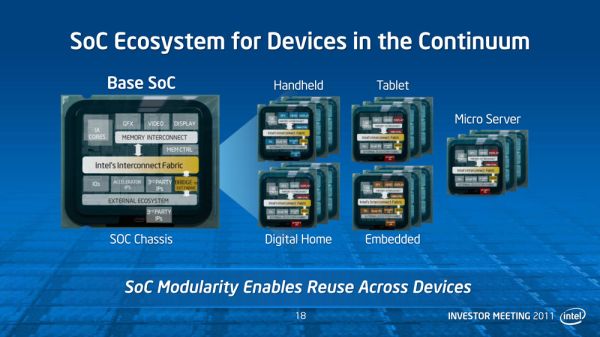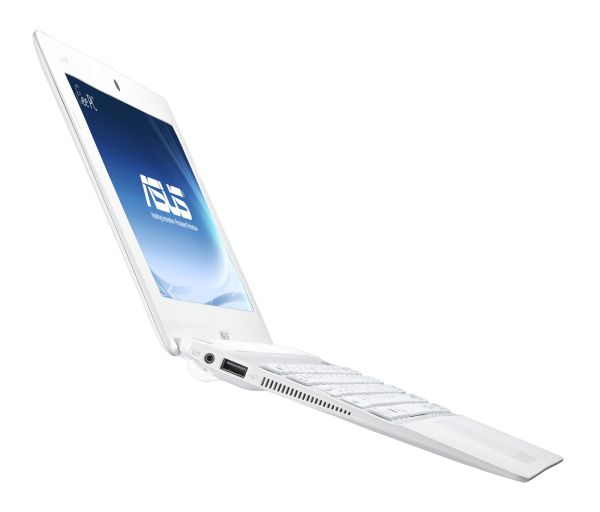The Ultrabook: Meet the New Thin and Light Intel Notebook
by Anand Lal Shimpi on May 31, 2011 12:01 AM EST- Posted in
- Laptops
- CPUs
- Intel
- Atom
- Haswell
- Computex 2011
- Trade Shows
- Ultrabook
Where Does This Leave Atom?
When Haswell hits in 2013, Intel will also update the Atom line to introduce the recently announced Silvermont architecture. As I speculated publicly before, based on Intel's hint to me five years ago that Atom would remain in-order for five years, I'm expecting Silvermont to be Intel's first Out-of-Order Atom.

When Atom was introduced, its microprocessor architecture was unlike anything we'd seen from Intel in years. It looked more like a modern take on the Pentium rather than a P6/Conroe derivative. That was nearly five years ago, so what do we expect Silvermont to look like? I'd say it might look a lot like a modern, ultra low power take on Conroe. Perhaps a limited Out-of-Order execution core, only a 3-wide front end and a number of other limitations to keep its power in check.
In the sub-10W range Intel is going to use Atom specifically for fanless designs - the next generation of netbooks as well as tablets. Cedar Trail is Intel's 32nm Atom platform which we've talked about already, which will be used in netbooks such as ASUS' newly announced EeePC X101:
Medfield is the ultra mobile version of Atom, destined for handsets and tablets, and at the show we should finally see a Honeycomb (Android 3.0) tablet running the SoC. Unfortunately with NVIDIA Tegra 2 based tablets moving to Android 3.1 already, and Medfield designs not due out until later this year I'm wondering if that may be too little too late.

Expect more coverage on Intel's announcements at the show as we come by them.















33 Comments
View All Comments
soydeedo - Tuesday, May 31, 2011 - link
Haha, you super sleuth, you. Thanks for the help. =)I actually thought that might be it because of the giant hinge connection/protrusion, but when I went on Google's image search looking for profile pics, nothing really caught my eye. It's a shame, though - I was hoping there was a fully fledged notebook that looked like that. It looks great from that angle anyhow.
duploxxx - Tuesday, May 31, 2011 - link
The final requirement is all Ultrabooks must be sold at mainstream price points, which Intel calls sub-$1000.Intel estimates that by the end of next year 40% of consumer notebooks will be Ultrabooks. Given the desirable set of features and reasonable price point, I can see that happening.
With that pricepoint? your joking right? the share will be about 1-2% some geeks that want to show off on an airport or tradeshow. For that price i buy a decent tablet and a notebook. They will only be able to meat there perf goals in 2013, competition isn't idle in that area.
7x GPU perf means HD3000 like if they calculate from atom based right now, that ain't magic either :), that will just be brazos perf in early 2012 :).
A5 - Tuesday, May 31, 2011 - link
Apple has reached 5+% of the notebook market selling almost exclusively $1000+ products.If I were spending the same amount of money either way, I'd rather have a super-thin notebook than a tablet + a "normal" laptop.
Dribble - Tuesday, May 31, 2011 - link
Got to agree. It's just a macbook air for windows with a different name. The macbook air for mac hasn't sold that well, and that's got all the apple fanboys that should love this sort of thing. The windows market is going to be substantially smaller - haven't other companies already tried this sort of thing?Now if it was $400 they'd sell plenty but it's not so I don't see how it'll ever be more then a tiny niche market.
name99 - Tuesday, May 31, 2011 - link
"The macbook air for mac hasn't sold that well, "And you know this based on the scientific technique of pulling a number out of your ass?
COMMON SENSE would tell us that the product is doing well, given that Apple broadened the line from one to two different models. But we can do more than that, we can look at the numbers.
Q4 2010 Apple sold 1.1 million macbook airs. How does that compare?
In the same period, Apple sold a total of 2.9 million notebooks.
I'd say that's doing pretty well.
jjj - Tuesday, May 31, 2011 - link
" I fully expect Ivy Bridge to target relatively similar TDPs as Sandy Bridge"Is that just an assumption or any solid info? The combination of smaller process and FinFET might allow them to play a bit with perf,power consumption and dies size.
TEAMSWITCHER - Tuesday, May 31, 2011 - link
I am suspicious about this statement well. The big TDP drop should happen with Ivy Bridge and its process change. Haswell, using the same process, will also have a much lower TDP. If not, I fear that the ultra book will get to market too late to counter the growing onslaught of ARM tablet.Khato - Tuesday, May 31, 2011 - link
Here's to hoping that they can actually bring it to fruition. There might be a decent chance of it happening, since I'd bet that Intel is basically taking their learnings from trying to get into the phone and tablet market and applying them to a notebook platform. After all, why can't the same basic tricks used in an atom smartphone be applied to a sandy/ivy bridge laptop? Especially since they could now bring 4G mobile connectivity into the platform the same way they brought wireless into the mainstream with centrino. There's some pretty awesome potential, that's for sure.Calabros - Tuesday, May 31, 2011 - link
at the middle of 2012 ULV IvyBridge (22nm) will be far better in performance/watt ratio than high end Saltwell Atom (yet 32nm).. and its exactly the gap AMD will fillA5 - Tuesday, May 31, 2011 - link
With what? They haven't said anything about updates to Llano for that timeframe.